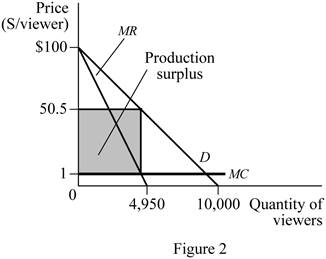
(a)
The
(a)
Explanation of Solution
The inverse demand function calculated using Equation (1) is as follows:
The marginal revenue can be calculated as follows:
The marginal revenue function is
Given the marginal cost is $1.
The profit of a firm is maximized when the marginal revenue is equal to the marginal cost.
The profit is maximized when the quantity of output produced is 4,950.
The price charged by the monopolist to maximize the profit can be calculated by substituting the value of profit maximizing output in Equation (1).
Thus, the profit maximizing output is 4,950 and the profit maximizing price is $50.50.
When the market is in
Thus, the competitive quantity is 9,900.
Figure 1 given below shows the deadweight loss of the monopoly.

The horizontal axis of Figure 1 measures the quantity of viewers and the vertical axis measures the price. The demand curve and the marginal revenue curve are downward sloping curves. The shaded area of the graph indicated as the DWL is the deadweight loss of the monopolist.
The deadweight loss is the area given by DWL. It can be calculated as follows:
Thus, the deadweight loss is $122,512.50.
Marginal revenue: Marginal revenue is defined as the additional revenue earned by a firm due to the production of an extra unit of output.
(b)
Spending for the broadcast rights.
(b)
Explanation of Solution
There are five networks and they will be willing to pay the
Figure 2 given below shows the producer surplus of the

The horizontal axis of Figure 1 measures the quantity of viewers and the vertical axis measures the price. The demand curve and the marginal revenue curve are downward sloping curves. The shaded area of the graph indicated as the producer surplus is the producer surplus of the monopolist.
The producer surplus is the shaded area given by area of the rectangle. It can be calculated as follows:
Thus, the producer surplus is $245,025. Thus, each network would pay $245,025 for the broadcast rights.
Producer Surplus: The producer surplus is defined as the difference between the actual market price for which a commodity is sold and the minimum cost at which the producer is willing to sell the commodity. This minimum accepted price is usually the cost of production of the commodity.
(c)
The loss.
(c)
Explanation of Solution
When the networks pay additional cost for the broadcast rights on lobbying apart from the deadweight loss, the loss in the society is greater than that in a monopoly. There is also a possibility that the many firms may adopt the same strategy and this would increase the expenditure of the society. When the networks are willing to pay the producer surplus for the broadcast rights, this becomes a rent seeking activity. The amount of potential waste that arises due to this activity can be calculated as follows:
It is evident that this amount is greater than the deadweight loss. Since the networks have to pay the producer surplus to retain their broad cast rights, the loss of the society would be large.
Deadweight loss: Deadweight loss is defined as the loss of the total
Want to see more full solutions like this?
Chapter 9 Solutions
LaunchPad for Goolsbee's Microeconomics (Six Month Access)

 Principles of Economics (12th Edition)EconomicsISBN:9780134078779Author:Karl E. Case, Ray C. Fair, Sharon E. OsterPublisher:PEARSON
Principles of Economics (12th Edition)EconomicsISBN:9780134078779Author:Karl E. Case, Ray C. Fair, Sharon E. OsterPublisher:PEARSON Engineering Economy (17th Edition)EconomicsISBN:9780134870069Author:William G. Sullivan, Elin M. Wicks, C. Patrick KoellingPublisher:PEARSON
Engineering Economy (17th Edition)EconomicsISBN:9780134870069Author:William G. Sullivan, Elin M. Wicks, C. Patrick KoellingPublisher:PEARSON Principles of Economics (MindTap Course List)EconomicsISBN:9781305585126Author:N. Gregory MankiwPublisher:Cengage Learning
Principles of Economics (MindTap Course List)EconomicsISBN:9781305585126Author:N. Gregory MankiwPublisher:Cengage Learning Managerial Economics: A Problem Solving ApproachEconomicsISBN:9781337106665Author:Luke M. Froeb, Brian T. McCann, Michael R. Ward, Mike ShorPublisher:Cengage Learning
Managerial Economics: A Problem Solving ApproachEconomicsISBN:9781337106665Author:Luke M. Froeb, Brian T. McCann, Michael R. Ward, Mike ShorPublisher:Cengage Learning Managerial Economics & Business Strategy (Mcgraw-...EconomicsISBN:9781259290619Author:Michael Baye, Jeff PrincePublisher:McGraw-Hill Education
Managerial Economics & Business Strategy (Mcgraw-...EconomicsISBN:9781259290619Author:Michael Baye, Jeff PrincePublisher:McGraw-Hill Education





